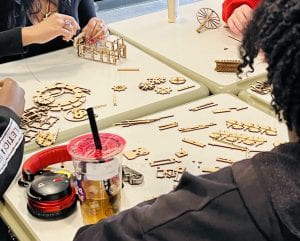By Urmi Poddar, Ph.D.
Postdoctoral Associate
Department of Ecology and Evolution
When I first started as a Teaching Assistant in BIO341: Plant Diversity, a content-heavy course with lots of jargon and memorization, I initially focused on creating detailed presentations with step-by-step lab instructions and terminology reminders. I soon realized, however, that students were drowning in information and losing sight of the bigger picture. Over the next four years, in my roles as a TA and guest lecturer, I experimented with and observed the instructor experimenting with different ways to help students make sense of all that content. I wanted students not just to memorize facts but also understand how the pieces fit together all while enjoying the course and having an overall positive learning experience. Over time, I found a few small strategies that made a big difference:
Drawing Connections Between Topics
Students may have had experiences in past biology courses where they were overwhelmed by a jumble of facts and jargon to memorize which can cause them to lose interest and shut down. Experienced biologists can see how different pieces of information connect together to form a bigger picture, but novice learners may need help drawing these connections.
In BIO341, students learn about plant evolution and the characteristics of different plant groups in lectures and then look at the anatomy of these plants in the lab. To help them connect these anatomy labs to the bigger picture of evolution, in the first few labs of the semester, I explicitly compare different plant groups and point out how their anatomy reflects their evolutionary relationships. Later in the semester, students are asked to make these connections on their own through discussion questions. Students say that these connections between the labs and lecture, and between different lecture topics have helped to make things “click” for them.

Breaking Up the Monotony with Clicker Questions
Pointing out connections between topics through lectures is great, but lectures themselves can lose students pretty quickly if they are not engaged. While there are many ways to make things more interesting, one simple strategy I often use is clicker questions/audience polls (no physical clickers required!). I intersperse my lectures with multiple choice or true/false questions to check understanding and retention. This strategy works particularly well if students are also given opportunities to apply what they have learned. For example, when teaching about plant families, I show pictures of plants and ask students to identify the family, thus helping them remember the characteristics of each family. These questions can also be used to assess students’ prior knowledge and misconceptions, ensuring everyone is on the same baseline. While there are many polling tools and plug-ins available, our university currently has Vevox which has many different types of questions and features. With that said, a quick show of hands to indicate agreement with a particular answer works just as well.

Making Learning Personal: Self-Refection Questions
Another step I took towards making the course more engaging was helping students connect the material to themselves through self-reflection questions. Self-reflection questions can foster students’ curiosity and improve knowledge retention by helping them link new topics to prior knowledge and personal interests (Symons & Johnson, 1997; Hulleman & Harackiewicz, 2009; Renninger & Hidi, 2022). During the pandemic, we used self-reflection questions extensively to make sure students kept up with readings in an online setting. This also helped us to gauge their struggles and get to know them better.
Some examples of self-reflection questions we have used include:
-
- Which parts of <topic/reading material> did you find most interesting or surprising? Which aspects of your background and past experiences made these interesting/surprising to you?
- Which parts of the <topic/reading material> did you find confusing or challenging? What steps have you taken or will you take to better understand these parts?
-
- Find a question you got wrong on <previous assessment/exam>. What misconceptions or knowledge gaps did you have, that may have led you to answer incorrectly? Try to answer the question again, based on the feedback you received.

In-Class Feedback
While designing course materials and assessments are important, feedback is also an essential part of helping students stay motivated and helping them to align their efforts with their learning goals. This is where TAs can really shine, as they are usually the ones in-charge of grading and feedback. In theory, effective and timely feedback can improve student motivation and engagement by showing them where they stand and how they can improve (Hattie & Timperley, 2007). But in practice, a TA may spend hours crafting the perfect feedback, and the student may never even look at it!
In BIO341, to ensure students actually engage with feedback on lab reports, we asked them to complete their reports in class and show them to the TA before final submission. They then would receive feedback on their drafts, and were asked to correct any mistakes or omissions before leaving. This greatly improved the quality and completeness of students’ final reports and helped catch mistakes and misconceptions early. The following resources provide more information on giving effective feedback:
Final Thoughts
Courses on content-heavy topics such as biology don’t have to be boring, and the newest tech-tools are not necessary or required to make them engaging (though when used well they can be a great asset to the learning experience). In my experience, even simple changes, such as the ones mentioned above, along with instructors’ willingness to experiment and observe, can make a world of difference.
References
Hattie, John, and Helen Timperley. “The power of feedback.” Review of educational research 77.1 (2007): 81-112.
Hulleman, Chris S., and Judith M. Harackiewicz. “Promoting interest and performance in high school science classes.” science 326.5958 (2009): 1410-1412.
Renninger, K. Ann, and Suzanne E. Hidi. “Interest development, self-related information processing, and practice.” Theory into practice 61.1 (2022): 23-34.
Symons, Cynthia S., and Blair T. Johnson. “The self-reference effect in memory: a meta-analysis.” Psychological bulletin 121.3 (1997): 371.

 What is your favorite part of your job?
What is your favorite part of your job? What is your favorite part of your job?
What is your favorite part of your job?












